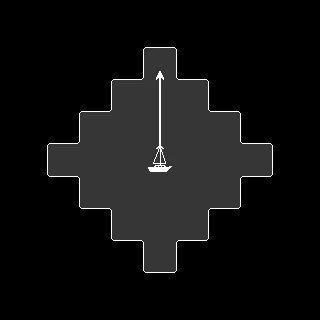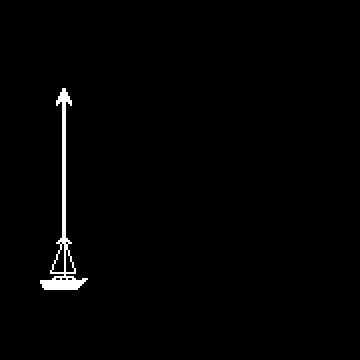Idea
After creating a component that allows highlighting an area on a grid, I thought about using fewer tiles and relying on transformations for other components. The first that came to mind was a path drawing component. In grid-based strategy games showing a path that a unit can take is pretty common.
Changing the texture easily, based on type of movement or type of unit might be useful. I plan to use only four neighbors per grid cell. This means eliminating diagonal movement, but it also means fewer tiles.
I designed this component with exactly four tiles in mind: ORIGIN, STRAIGHT, TURN and TARGET.
 Gridpath texture
Gridpath texture
Plan
Firstly, I needed to establish some design requirements.
- Use dependency injection for the main grid, as this component might be used in different settings, such as a world map or a battle map.
- Ensure compatibility with Godot’s
AStarGrid2Dimplementation. - Make it as easy to use as possible.
Godot scene
As a base node, I chose Node2D. Component exports two variables: tile_map - grid it will reference, and texture with four tiles.
To draw a path, programmer needs to assign a value to cells_array, which takes the output from AStarGrid2D and then draws resulting path calling draw_path function, provided it is valid.
Component also keeps track of steps_array, which will be helpful in a process of determining each of the tiles.
extends Node2D
class_name GridPath
@export var tile_map: TileMapLayer
@export var texture: AtlasTexture
var cells_array: Array[Vector2i]:
set(value):
cells_array = value
if cells_array.size() >= 2:
draw_path()
var steps_array: Array[int] # 0 - up, 1 - right, 2 - down, 3 - left
Drawing path stored in cells_array as an array of Vector2i variables is handled by draw_path function. In the first step, it removes all current children, then calls create_steps_array and spawn_path_elements in sequence.
To create steps array, the program clears steps_array, then loops through cells_array and determines the value for each step by comparing grid coordinates of current and next cells.
Defining constants for each of the directions improves code readability.
func draw_path():
for n in get_children():
remove_child(n)
create_steps_array()
spawn_path_elements()
const UP = 0
const RIGHT = 1
const DOWN = 2
const LEFT = 3
func create_steps_array():
steps_array.clear()
for i in cells_array.size() - 1:
var cell = cells_array[i]
var next = cells_array[i + 1]
var direction: int
if cell.x < next.x:
direction = RIGHT
if cell.x > next.x:
direction = LEFT
if cell.y < next.y:
direction = DOWN
if cell.y > next.y:
direction = UP
steps_array.append(direction)
Just like when creating steps array, I defined constants for segments of the path, which makes the code more readable. The function that spawns a single path element takes the following arguments:
cell: the reference grid coordinates of the cell.cell_segment: determines what part of the texture should be used.cell_rotation: the rotation of current segment in degrees.flip: a boolean value that determinesscale.yof the element.
const ORIGIN_SEGMENT = 0
const STRAIGHT_SEGMENT = 1
const TURN_SEGMENT = 2
const TARGET_SEGMENT = 3
func spawn_path_element(
cell: Vector2i,
cell_segment: int,
cell_rotation: int,
flip: bool = false
):
var sprite2d = Sprite2D.new()
sprite2d.texture = texture.duplicate()
sprite2d.texture.region = Rect2(cell_segment * 32, 0, 32, 32)
sprite2d.rotation_degrees = cell_rotation
sprite2d.position = tile_map.grid_to_position(cell)
if flip:
sprite2d.scale.y = -1
add_child(sprite2d)
To spawn all the elements, function first places origin element. Then, it loops through all other cells, excluding the last one, determining correct segment, rotation and if it should be flipped before spawning the element. At the end, knowing that only the last one is left, script places target segment, ensuring correct rotation.
func spawn_path_elements():
spawn_path_element(
cells_array[0],
ORIGIN_SEGMENT,
steps_array[0]*90
)
for i in range(1, cells_array.size() - 1):
var segment
if steps_array[i - 1] == steps_array[i]:
segment = STRAIGHT_SEGMENT
else:
segment = TURN_SEGMENT
var segment_rotation
if segment == STRAIGHT_SEGMENT:
segment_rotation = steps_array[i]*90
else: #TURN_SEGMENT
segment_rotation = steps_array[i]*90 - 90
var segment_flip = false
if steps_array[i - 1] == RIGHT and steps_array[i] == UP:
segment_flip = true
if steps_array[i - 1] == LEFT and steps_array[i] == DOWN:
segment_flip = true
if steps_array[i - 1] == DOWN and steps_array[i] == RIGHT:
segment_flip = true
if steps_array[i - 1] == UP and steps_array[i] == LEFT:
segment_flip = true
spawn_path_element(
cells_array[i],
segment,
segment_rotation,
segment_flip
)
spawn_path_element(
cells_array[-1],
TARGET_SEGMENT,
steps_array[-1]*90
)
Effect
The GridPath component is easy to use and modify by simply changing the texture.
 Gridpath texture
Gridpath texture

Using the GridPath component to show torpedo attack path.
 Gridpath texture
Gridpath texture

Summary
I am happy with the component, I believe that all the design requirement outlined at the start of the process have been achieved. Possible improvements include:
- Inferring tilesize from the reference grid.
- Keeping the rotation as an abstract value and determining it in the
spawn_path_elementfunction. - Determining
segment_flipvalue only if the segment is a turn segment.
